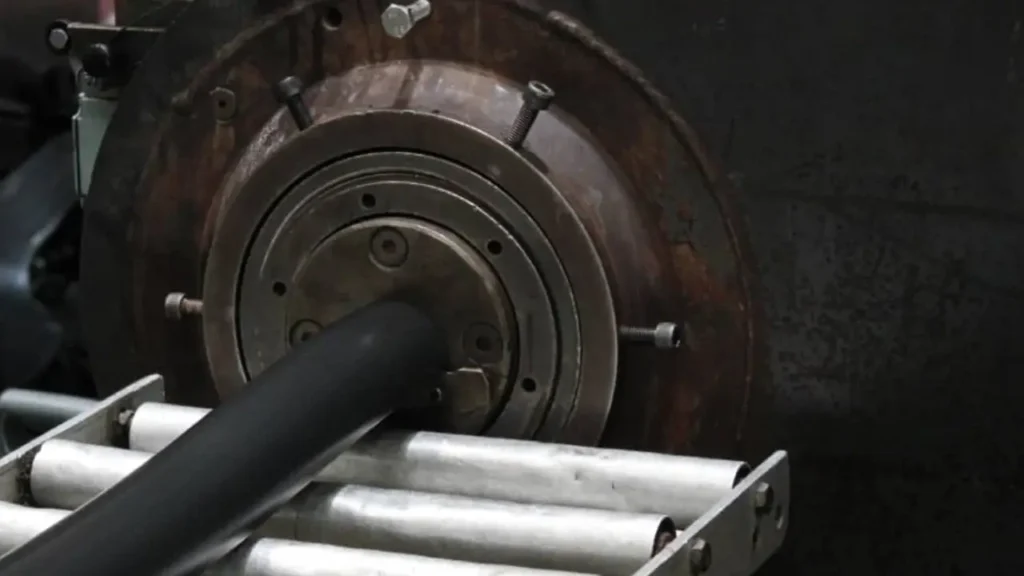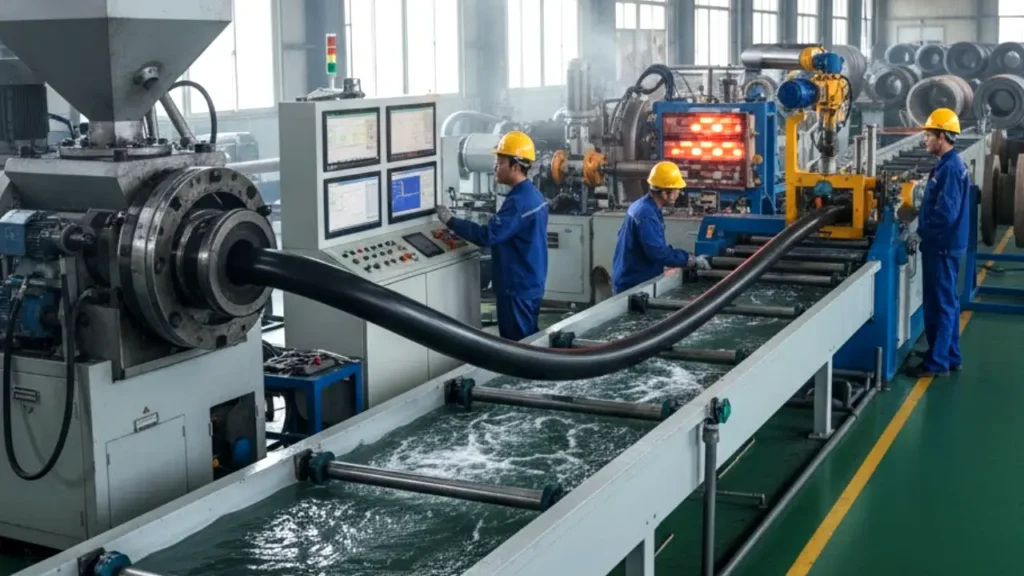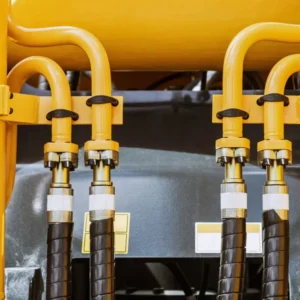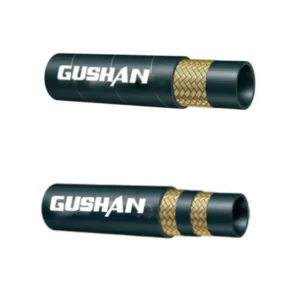The rubber hose extrusion process is the foundational manufacturing method for creating continuous, flexible rubber tubing vital to countless industries. From automotive fluid transfer to heavy-duty industrial applications, understanding how a raw compound transforms into a high-performance hose is essential. This comprehensive guide will break down the crucial stages of this intricate and indispensable manufacturing journey.
We’ll cover everything from the initial material preparation and specialized machinery to the critical steps of forming, curing, and final quality control. Whether you’re a material engineer, a manufacturing professional, or simply curious about this process, get ready for a deep dive into the technology that shapes the durable rubber hoses we rely on daily.
What is Rubber Extrusion?

Rubber extrusion is a continuous manufacturing process used to create objects with a fixed cross-sectional profile, such as tubes, seals, or specific shapes. In this process, uncured, or “green,” rubber compound is forced under high pressure through a precisely shaped die. The high pressure and friction cause the rubber to heat up and take the exact form of the die’s opening, resulting in a continuous length of rubber product.
The basic steps involve feeding the prepared rubber compound into an extruder machine, which uses a rotating screw to push the material toward the die. The consistency of the compound, the temperature, and the screw speed are all tightly controlled to ensure a uniform profile. After passing through the die, the extruded shape is typically cooled and then subjected to vulcanization (curing) in a separate stage, which permanently sets its shape, elasticity, and physical properties, making it ready for its final application.
What Are the Materials Used for Rubber Extrusion?
The choice of raw rubber compound is the most crucial decision in the extrusion process, as it dictates the final product’s performance characteristics. Extrusion utilizes a wide array of both natural and synthetic elastomers, each selected for its specific resistance to heat, chemicals, abrasion, or weathering conditions.
The material must not only meet the application requirements but also possess the proper viscosity and flow properties for smooth, continuous processing through the extrusion machinery and the die. Additives are blended into the base polymer to fine-tune these working characteristics.
- EPDM (Ethylene Propylene Diene Monomer) EPDM is highly valued for its excellent resistance to weathering, ozone, UV exposure, and extreme temperatures. It’s often the preferred material for outdoor applications like window seals, automotive weatherstripping, and gaskets, providing long-term durability in external environments.
- Nitrile Rubber (NBR or Buna-N) Nitrile rubber is primarily chosen for its exceptional resistance to petroleum-based oils, fuels, and grease. This makes it indispensable in the automotive and industrial sectors for manufacturing fuel hoses, hydraulic seals, and oil-resistant tubing where fluid contact is constant.
- Silicone Rubber (VMQ) Silicone stands out due to its superior temperature resistance, functioning reliably across an extremely wide thermal range from very low to very high. It is non-toxic and biocompatible, commonly used in medical tubing, appliance seals, and high-heat gaskets for specialized industries.
- Neoprene (CR or Chloroprene) Neoprene offers a good balance of properties, including moderate resistance to oils, chemicals, and weathering, coupled with favorable physical toughness. It is often used in general-purpose applications like industrial hoses, belts, and vibration mounts, exhibiting good flame resistance.
- Natural Rubber (NR) Natural rubber is prized for its high tensile strength, elasticity, and excellent abrasion resistance. While less resistant to oil and ozone than synthetic types, its superior resilience and tear strength make it ideal for flexible tubing, bushings, and high-wear-and-tear products.
Rubber Hose Extrusion Process

The rubber hose extrusion process is a highly controlled manufacturing method used to create continuous, flexible rubber tubing. It involves forcing a heated rubber compound through a shaped die to form the desired hose profile.
Step 1: Material Selection
The process of rubber extrusion begins with selecting the appropriate type of raw rubber or rubber compounds based on the desired properties of the finished product. This step considers factors like flexibility, durability, and chemical resistance to ensure the material suits the intended application.
This initial choice is critical as the polymer dictates the ultimate performance of the hose, including its ability to withstand extreme temperatures, pressures, or chemical exposure in its specific working environment.
Step 2: Rubber Compounding
During rubber compounding, the raw rubber is blended with additives such as fillers, plasticizers, and curing agents to achieve the desired mechanical and chemical properties. This step also optimizes the rubber for the extrusion process, improving its performance during pressure application and subsequent curing.
Careful blending ensures the compound is uniform, consistent, and exhibits the necessary flow characteristics for smooth extrusion. The precise formulation determines the final elasticity, hardness, and strength of the cured rubber hose.
Step 3: Feeding the Extruder
The prepared rubber compound is introduced into the extruder’s feeding system. A screw mechanism moves the material forward, ensuring a consistent supply for further processing. This step marks the starting point for the material’s transformation.
Consistent feeding is essential to prevent pressure and speed variations within the machine, which could lead to inconsistencies in the final hose profile or structural defects in the extruded product.
Step 4: Heating and Pressurizing
As the rubber moves through the extruder, it passes through a heating or cooling system to achieve the desired temperature for shaping. Simultaneously, the material is subjected to pressure application, which softens it, making it suitable for extrusion through the die.
Controlled heating lowers the compound’s viscosity, allowing it to flow easily, while the increasing pressure ensures the material is fully compacted and forced uniformly toward the restricted opening of the die.
Step 5: Extrusion Through the Die
The softened rubber is forced through an extrusion die, which shapes it into a continuous flow with the required cross-sectional profile. The precision of this step determines the uniformity and accuracy of the final product.
The die design is engineered to account for the rubber’s expansion upon exit (die swell), ensuring the finished hose dimensions meet the strict design specifications after the curing process is complete.
Step 6: Vulcanizing and Curing Agents
After extrusion, the product undergoes curing or vulcanization to improve its strength, elasticity, and durability. Curing agents ensure the material achieves its final physical properties, making it suitable for end-use applications.
This heat-activated chemical process forms permanent cross-links within the rubber’s polymer chains, turning the soft, plastic material into a stable, highly resilient, and flexible elastomeric hose.
Step 7: Cutting and Finishing
The extruded rubber is trimmed to the desired length and shape. Cutting or trimming ensures that the product meets the design specifications. Additional finishing processes are applied for quality control before it is considered ready for use.
Finishing may include surface treatment, branding, or the addition of fittings. Each hose length is thoroughly inspected to guarantee it is free of defects and adheres to all required performance standards.
What Are the Different Types of Rubber Extrusion?
The process of rubber extrusion can be classified into several distinct types, based primarily on the operating temperature and the material properties being achieved in the final product. Understanding these variations helps manufacturers select the most suitable technique for a required shape and specific performance criteria.
These methods allow for the creation of a vast array of continuous rubber profiles, from simple cords to complex multi-layered hoses, each tailored to its demanding application, whether in automotive, construction, or general industry.
- Hot Rubber Extrusion This common process heats the rubber compound to high temperatures before it is forced through the die. This heat significantly lowers the material’s viscosity, allowing it to flow and shape easily and quickly. It results in a very smooth surface finish and is suitable for high-volume, continuous production lines.
- Cold Rubber Extrusion Cold extrusion operates with the rubber at or near room temperature, relying more on intense mechanical pressure from the screw mechanism to process the material. This method minimizes heat-induced changes to the compound’s texture and is often preferred for specialized compounds or those requiring enhanced precision and material integrity.
- Solid Rubber Extrusion This technique involves processing rubber compounds without incorporating air or foaming agents into the mix. The goal is to produce dense, non-porous products like durable seals, thick strips, and heavy-duty conveyor belts that demand maximum strength, resistance to compression, and high elasticity for severe applications.
- Sponge Rubber Extrusion In contrast to solid extrusion, this method intentionally incorporates gas or foaming agents into the compound before it exits the die. This creates a lightweight, flexible material with an internal porous, or cellular, structure, making it ideal for compressible weatherstripping, gasketing, and shock-absorbing parts.
- Co-Extrusion (Dual Durometer) Co-extrusion is an advanced process where two or more different rubber compounds are simultaneously fed through a single die. This allows for the creation of multi-layered or dual-hardness profiles, effectively combining materials with distinct properties, such as a soft, sealing bulb on a rigid mounting base.
Conclusion
Mastering the rubber hose extrusion process is key to producing products that meet demanding performance and safety standards. From precise compounding and effective die design to meticulous vulcanization, each step ensures the hose has the required durability, flexibility, and resistance. By following these best practices, manufacturers can achieve efficient, high-volume production of exceptional quality.
The quality of the final extruded hose directly depends on attention to detail throughout the entire process. Consistent temperature control, uniform pressure, and rigorous quality checks are non-negotiable for success. If you’re looking for reliable supply and manufacturing excellence, trust a proven partner. To fulfill your bulk requirements, you can get wholesale rubber hoses from our Gushan Rubber
Thank you for joining us on this detailed exploration of rubber hose manufacturing. We hope this guide provides valuable insights for optimizing your production or sourcing needs. Remember, choosing the right supplier is as important as perfecting the process itself. For quality, volume, and competitive pricing, reach out to Gushan Rubber today to discuss your next wholesale order.



